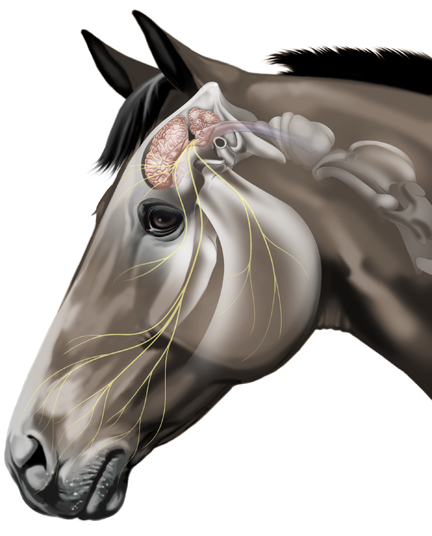Nerve’s role in headshaking investigated
- February 22, 2024
- ⎯ Christine Barakat with Mick McCluskey, BVSc
Researchers are a step closer to understanding the role played by the trigeminal nerve in equine headshaking.
Characterized by spontaneous and repeated flipping of the nose, headshaking can have many causes including allergies or poorly fitting tack. But when other factors are ruled out, veterinarians focus on the trigeminal nerve, which runs along each side of the face.
Click here to learn more about a study into headshaking relief measures.

In people, a condition known as trigeminal neuralgia causes burning or stinging sensations on parts of the face. Often triggered by activities such as eating or drinking, trigeminal neuralgia has been linked to demyelination, which is damage to the protective covering surrounding nerve fibers.
“Demyelination causes something called ephaptic conduction, so when the nerve impulse—which is an electrical signal—travels along the nerve and gets to the demyelinated area, it is the same as getting to an uninsulated part of an electrical wire. The impulse goes a bit crazy and triggers all the nerve fibers in the area, including the pain ones, to fire,” explains Veronica Roberts, MRCVS, of the University of Bristol.
Roberts and her research team set out to determine whether a similar process is at work in horses with unexplained headshaking. For their study, the researchers removed and dissected the trigeminal nerves of six horses euthanatized because of intractable headshaking. For comparison, they also removed and dissected the same nerve from four horses euthanatized for other reasons.
They found no evidence of demyelination of the trigeminal nerve or surrounding structures in any of the horses, even those euthanatized because of severe headshaking.
These findings don’t mean the trigeminal nerve isn’t involved in headshaking, says Roberts; instead they suggest that the pathology is different from the one in humans—and that may be a good thing.
“It’s definitely trigeminal nerve pain, just not due to demyelination,” she says. “The nerve is sensitized and firing at too low a threshold. We don’t know why that happens, but with no structural abnormality detected in the nerve, it suggests it’s a functional abnormality. It gives hope for treatment like neuromodulation to work.”
Don’t miss out! With the free weekly EQUUS newsletter, you’ll get the latest horse health information delivered right to your in basket! If you’re not already receiving the EQUUS newsletter, click here to sign up. It’s *free*!
This article first appeared in EQUUS #481





